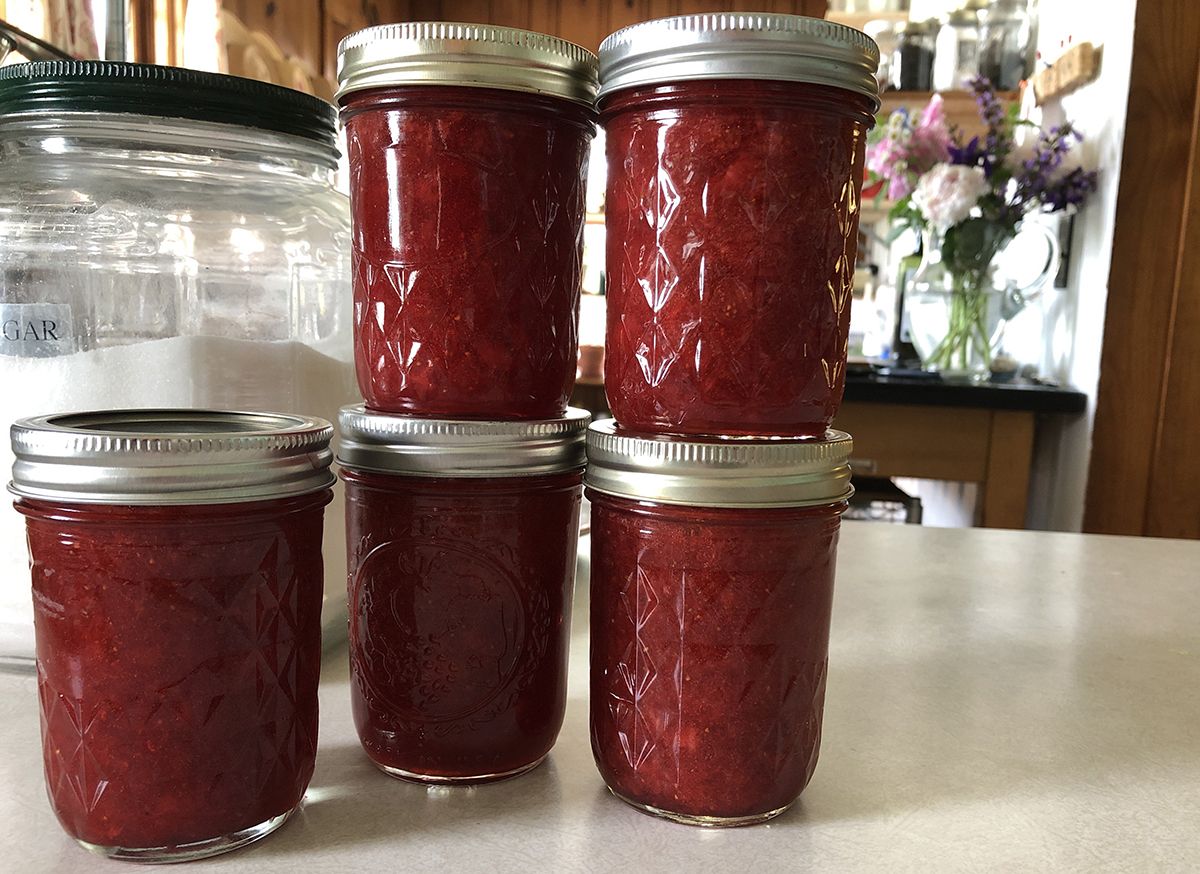
Leave the rings on the jars until the lid has sealed and the jars are cool. Then you can remove the rings, wipe the tops of the jars and store at room temperature for up to a year. (Kayte Young)
Making jam is easier than you might think--especially with berries, since they don't require much preparation. Taking the extra step of canning the jam makes it shelf-stable, and it only takes a bit more time and know-how.
This recipe uses Pomona’s Pectin, which does not require the massive amounts of sugar that regular pectin (such as Sur-jel) does. It allows the flavor of the fruit to really shine. You can find Pomona's locally at Bloomingfoods or order it online. The box includes detalied instructions for all kinds of jam, including freezing and canning methods.
Below are the steps for making and canning strawberry jam. You can easily adapt this for other berries by following the recipes in the Pomona's packet.
You can see a video of me making this jam on the Earth Eats YouTube channel.
What you'll need
4 cups mashed fresh strawberries (you can use other berries, but check the Pomona's instruction sheet for the specific recipes. Some call for lemon juice)
1-2 cups of sugar
2 teaspoons Pomona’s Pectin
2 teaspoons calcium water (made with ½ teaspoon of calcium powder--included in Pomona's Pectin--and ½ cup water in a small jar. Shake to combine, store in the fridge)
If canning, you will also need the following:
5 half pint canning jars, with two-part canning lids (the flat lid part needs to be new, the rings can be reused)
Large stock pot, with lid
round wire rack to fit into the bottom of the pan (keeps the jars off of the bottom)
jar lifter, or sturdy tongs
canning jar funnel (optional)
ladle
small cloth made of t-shirt material (to wipe the rims of the jars after filling)
kitchen towel and potholders
To prepare the jam
Rinse the fruit and remove strawberry hulls. Mash berries (rough chopping can help with this) and measure 4 cups. Heat mashed strawberries in a stainless steel pan over medium high. Stir in 2 teaspoons of calcium water. As the fruit softens, mash it more and bring mashed fruit to a boil.
Meanwhile mix the sugar with the pectin in a bowl. Add to boiling fruit, stirring quickly and vigorously, to avoid any lumps.
Bring to a boil again, then remove from heat. Using a ladle and jar funnel, pour the jam into clean jars and refrigerate. To make the jars of jam shelf stable, use a boiling water bath canning process (below).
To can the jam (boiling water bath method):
Before starting anything, place a wire cake cooling rack in the bottom of a large deep pot. Fill about halfway with water, add 5 clean ½ pint canning jars. Bring to a boil. Remove jars when jam is ready, keep the water hot/near boiling
Ladle the hot jam into hot jars leaving ¼ inch headspace. Wipe rims and place new canning lids on top. Seal with metal rings (finger tight) and carefully place into the pot of boiling water. Make sure water covers the tops of the jars when all jars are placed in the pot. Bring water back to a boil, once boiling, set timer for 10 minutes.
After 10 minutes, remove jars to a cooling rack or towel using tongs or a jar lifter. When jars are completely cool, and canning lids are sealed, remove rings, and wipe down the outside of the jar. Label and include date.
If the fruit seems to be separating, you can gently shake the jars during the cooling time, once the jars have sealed. You may need to do this a few times.
Note: boiling water bath canning is only suitable for fruits and highly acidic products such as pickles. If you are canning vegetables that are not pickled with vinegar, then you must use a pressure canning method or run the risk of contamination with botulism. Always consult with a University Extension program for canning recipes and procedures. Their information is backed by research.













